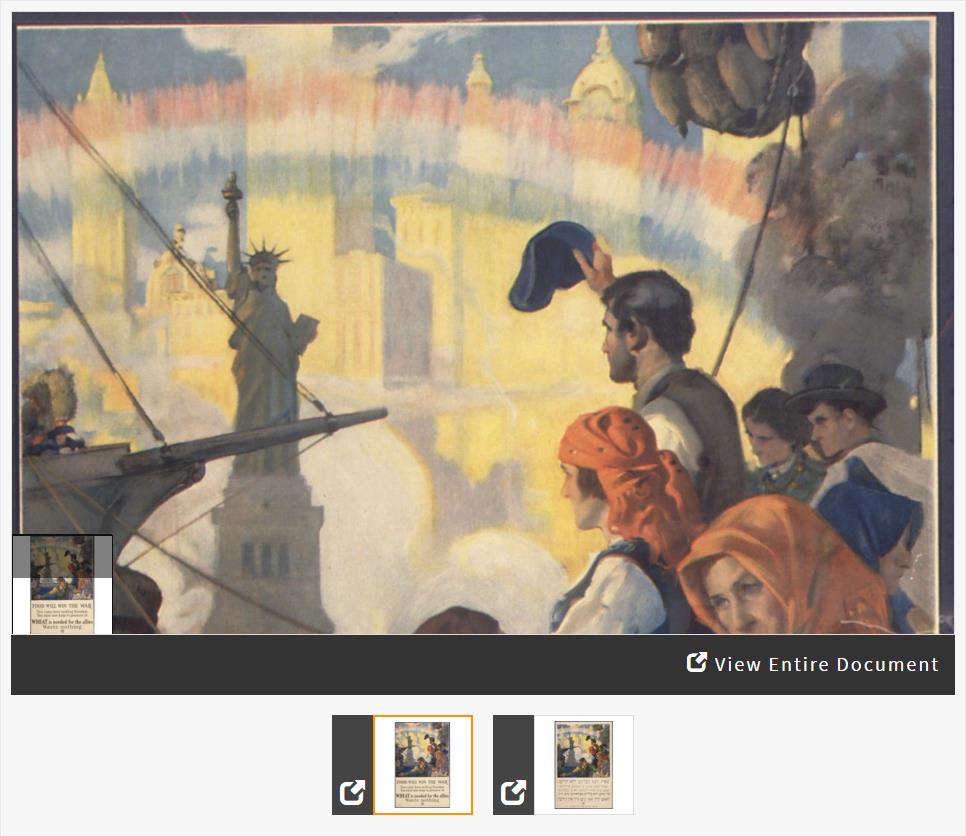Students will speculate why the U.S. Food Administration created posters urging Americans to conserve wheat in multiple languages, and what techniques the administration used to appeal to citizens.
Suggested Teaching Instructions
Students will analyze World War I-era posters urging Americans to conserve food. They will identify the target audience and determine how the U.S. Food Administration tried to appeal to Americans to help the war effort. For grades 6-8. Approximate time needed is 15 minutes.
This activity is intended as a warm-up or introduction to home-front war efforts in a full-class setting. The two posters are identical except for the language in which each is printed - one is in English, the other Yiddish.
Project the activity for the class using a computer and projector or interactive white board. Share with students that on August 10, 1917, in the midst of World War I, President Woodrow Wilson issued Executive Order 2679-A, creating the U. S. Food Administration. It regulated the supply, distribution, and conservation of food during the war. It’s goal was to help America and its allies win the war by saving enough food to send to the Allies.
The U.S. Food Administration, headed by future president Herbert Hoover, was to implement the government's policy as set forth in the Food and Fuel Control Act (40 Stat. 276), also known as the Lever Act, passed by Congress earlier that year.
Operating in each state, its tasks were to:
- Assure the supply, distribution, and conservation of food during the war,
- Facilitate transportation of food and prevent monopolies and hoarding, and
- Maintain governmental power over foods by using voluntary agreements and a licensing system.
Ask students to analyze each poster, paying attention to the images and text. Ask students to respond to the questions on the screen in writing or with a partner. Then ask them to contribute their answers in a full-class discussion.
Students may speculate that the U. S. Food Administration created these posters in different languages to appeal to different audiences, and that there were different immigrant groups in America speaking different languages. A key technique of the Administration was to create and distribute posters and other materials urging Americans to conserve food.
Charles E. Chambers’ poster of 1917, printed in several languages, including Yiddish and Italian, targeted immigrants, combining patriotic symbols urging for the conservation of wheat. Ask students to infer what immigrant groups were in America at the time based on the languages in which the posters were published. Tie this to the influx of immigrants from southeastern Europe around the turn of the century.
Students may propose that the immigrant experience was similar for many new Americans, but that customs and language for each group would differ based on their home countries, even after immigrating to America.
Discuss with students symbols they've listed from the poster. Click on the arrow icons and magnifying glasses in the blue bar at the bottom of the image to explore the details that students find. Notice the Statue of Liberty, ships, buildings, colors, facial expressions, and text. Click "When You're Done" to get to the follow-up questions and brainstorm answers with the class:
• What emotions or feelings was the poster designer trying to create in the audience?
• Do you think this would have been an effective way to get Americans to contribute to the war effort? Why or why not?
Some information excerpted from Teaching With Documents: Sow the Seeds of Victory! Posters from the Food Administration During World War I.See more documents from the U.S. Food Administration. For more information about the featured documents, follow the links below.





